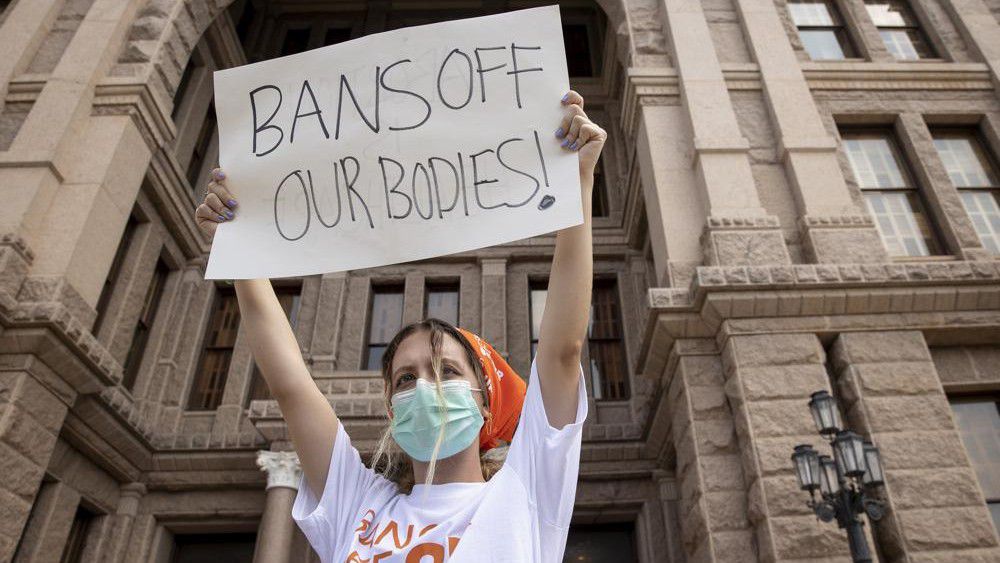DALLAS — Young people on social media have found a way to protest Texas’ new law banning most abortions by focusing on a website established by the state’s largest anti-abortion group that takes in tips on violations.
They’ve shared short videos and guides on how to flood the Texas Right to Life site with fake information, memes and prank photos; it’s an online activism tactic that comes naturally to a generation that came of age in the internet era.
“I got the idea of, OK, well, we can sabotage these things online. It’s kind of like internet activism. Is it something we can realistically do and it’s not going to take us very long to do it,” said an 18-year-old TikTok user who goes by the name Olivia Julianna, using only her first and middle name due to safety concerns.
The law that took effect this month prohibits abortions once medical professionals can detect cardiac activity, which is usually around six weeks and before some women know they’re pregnant. It doesn’t make exceptions for rape or incest.
Though abortion providers say the law is unconstitutional, they say they are abiding by it.
“The law was not actually designed to be carried out in the sense of litigation, it’s designed to deter,” said Joanna Grossman, a law professor at Southern Methodist University in Dallas. “It’s just designed to bring the entire system of women’s health care to a screeching halt through fear.”
The website was down over the long weekend after host GoDaddy kicked it off, saying said it violated the company’s terms of service, including a provision against collecting identifying information without consent. As of Tuesday, the site was being redirected to Texas Right to Life’s main website.
Texas Right to Life spokeswoman Kimberlyn Schwartz said Tuesday that the website’s domain is now registered with Epik and they’re in the process of moving to a new host, but aren’t yet disclosing which one. Epik used to host 8chan, an online message board known for trafficking in hate speech. Epik representatives haven’t responded to a message seeking comment Tuesday.
Schwartz said they are working to get the tipster website back up but noted that in many ways it is symbolic since anyone can report a violation. And, she said, abortion clinics appear to be complying with the law.
“I think that people see the whistleblower website as a symbol of the law but the law is still enforced, with or without our website,” Schwartz said, adding, “It’s not the only way that people can report violations of the law.”
Rebecca Parma, Texas Right to Life’s senior legislative associate, said they expected people to try to overwhelm the site with fake tips, adding “we’re thankful for the publicity to the website that’s coming from all of this chatter about it.”
And, Parma said, the website is just “another facet of the network we already have in place.” She said they have a network of anti-abortion attorneys and citizens who work with them, including people who are posted outside of abortion clinics and talk to people going in and coming out.
Julianna, who lives in Texas and has more than 136,000 TikTok followers, said that while she sees the tip website as more of a “scare tactic” than a threat, she has taken comfort in the like-minded people she’s found in her quest to thwart it.
“We’ve grown up in this new age of technology,” she said. “So now you don’t feel so isolated with what you believe in and your activism.”
Sean Wiggs, 20, who goes by Sean Black on TikTok, came up with a shortcut people could use to autofill the questions on the site. Wiggs, who lives in North Carolina, said he has received an “overwhelmingly positive” response on social media, and that he hopes efforts like his lead to more people “realizing the power that you have online.”
Julianna said she was inspired by TikTok activists who last year flooded a registration website for a rally in Oklahoma for then-President Donald Trump, although they had no intention of attending. While it’s unlikely they were responsible for the low turnout, their antics may have inflated the campaign’s expectations for attendance numbers that led to a disappointing crowd.
The law, which legal experts say was written in a way that puts defendants at a severe disadvantage, has left abortion providers leery of the potential cost of fighting a flood of frivolous lawsuits.
“I’ve never seen a statute that combines so many elements to disadvantage the defendant,” said Seth Chandler, law professor at the University of Houston.
For one, if the plaintiffs win, they can get attorneys fees and costs, Chandler said. If the defendants win, they can’t. Also, there could be multiple lawsuits filed in different counties based on the same allegation, and the statute prohibits a change of venue, he said.
“Even if the accusations that these vigilantes make are untrue, the staff and physicians would be put in the position of having to defend themselves in court, hire attorneys, travel for hearings, who knows in what county in Texas,” said Amy Hagstrom Miller, CEO of Whole Woman’s Health, which has four abortion clinics in Texas.
Dr. Jonathan Metzl, a professor of sociology and psychiatry at Vanderbilt University, said that although the website seems “comically inept at this point,” it does “what the actual law on the books is asking people to do, which is to report on people.”
Wiggs said that aspect of the law, the “way that they are deputizing private citizens to incentivize them to snitch on their neighbors,” really stood out to him.
“It’s just the way that they’re turning people against each other over an already polarizing topic such as abortion,” Wiggs said.
Texas has a history of creative forms of protest. In 2016, college students protested a new law allowing people to carry concealed handguns in public places, including universities, by walking around campus with sex toys in their hands and strapped to their backpacks, calling the protest “cocks not Glocks.” It got attention.
But, Metzl notes, it didn’t stop the Legislature enacting laxer gun laws.
“It’s a form of protest and resistance, but it hasn’t been effective changing policy,” he said. “The best way to change policy is to win elections.”










